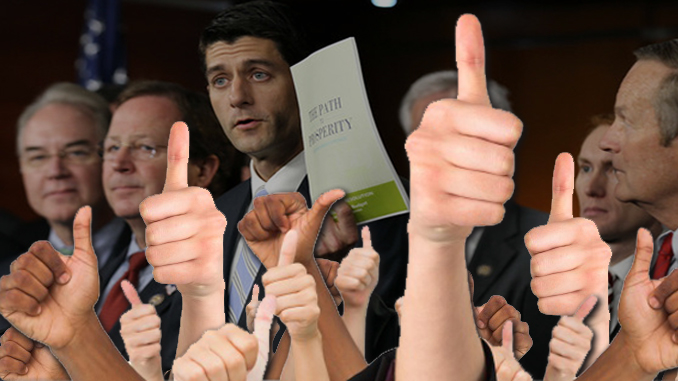
The House Budget Committee, under Chairwoman Diane Black (R-Tenn.), has taken a strong first step toward reining in out-of-control federal spending by putting forward a budget that cuts $200 billion from “mandatory spending” over the next decade. It’s a start.
By Robert Romano
Sixty-nine percent of the $3.8 trillion federal budget consists of so-called “mandatory” spending. That is, $2.7 trillion of spending that occurs automatically whether or not Congress votes to adopt a budget or even pass a single appropriations bill—a constitutionally dubious process, but there it is.
Much of it includes things like Social Security ($910.2 billion), Medicare ($588.4 billion), Medicaid ($368.3 billion), food stamps ($96 billion), and unemployment payments ($32.3 billion). It also includes interest owed on the nearly $20 trillion national debt, now $429.9 billion, including $145 billion of interest paid to government trust funds.
This is the spending that occurs on autopilot, and tends to increase every year based on the population of people eligible to receive the benefits increases. This is why they are often called entitlements, because recipients are “entitled” to receive them under the law, although many readers might take exception to that term because they paid taxes into those programs. Fair enough.
Bug Out While You Still Can! Learn More…
But because it increases almost every year, it is refreshing then to finally see a proposal coming out of Congress that would cut other parts of it—without touching Social Security or Medicare that seniors depend on.
The House Budget Committee, led by Chairwoman Diane Black (R-Tenn.), has put a budget on the table that would actually cut so-called “mandatory” spending by $200 billion over the next decade off of the baseline. It actually started out as $150 billion of cuts, but another $50 billion was added to offset planned increases in defense spending.
Guess mandatory spending isn’t so mandatory after all.
It may seem comparatively small, a little less than 1% of the mandatory spending budget, but Chairwoman Black says it’s a start.
“I strongly believe that we need to begin to address mandatory spending and to change the culture of Washington with real reforms. This is an important first step that we can continue to build on in future Congresses,” Black said in an emailed statement.
It could add up. For example, if Congress found $200 billion of 10-year cuts every year out of mandatory spending, after five years, that would add up to $1 trillion of real savings over 15 years.
That’s still a ways to go to get to the $2.5 trillion of mandatory spending cuts proposed over the next decade in the Trump budget, but we’re making progress.
So far, it is not clear where the $200 billion of cuts will specifically fall, as House committee leaders hammer out the details. But, said Americans for Limited Government President Rick Manning, it’s a step in the right direction.
“We have to get the nation’s $20 trillion debt under control, and Congress’s part in that is clamping down on spending. The House’s constitutional role is to set the stage for the nation’s spending priorities. Chairwoman Black’s budget is doing what Congress is supposed to do, which is to set priorities and make choices,” Manning said.
Manning also called on Congress to build on the proposal, with even more cuts: “The only amendments that should be accepted to Chairwoman Black’s budget are additional deficit-reducing cuts.”
To which, there is a major incentive in Congress’s budget rules. The budget bill Chairwoman Black is working on is supposed to become the basis of the tax cut bill Republicans want to pass on budget reconciliation. Rightly or wrongly, tax cuts get counted toward the deficit by the bean counters at the Congressional Budget Office.
Meaning, the bigger the spending cuts that go into the bill, the bigger the tax cuts Congress will be able to get via the budget rules.
Just one more reason for the American people to root for more spending cuts in the budget as this legislation winds through the budget reconciliation process.
After the budget is signed into law by President Trump, don’t forget to thank Chairwoman Black when you get your tax refund next year.
Robert Romano is the senior editor of Americans for Limited Government.




One penny of every dollar? That’s outrageous being that our country is at least $20 Trillion in debt. Cut 75% of defense & no one will notice since it is cutting waste not real defense.
I don’t see what all the praise is about. This is more smoke-and-mirrors. The 19 “out-years” of the “cuts” have no meaning or value, as Congress rarely if ever holds to the original “budget” in later years–and it is not obliged to do so.
Besides, it is almost certain that the cuts, if they take place, will punish senior citizens by depriving them of more of their Social Security benefits, to which they are strictly entitled in justice, because they paid into that system.
The other favourite places to cut are Veterans’ benefits–although the war industry always gets more money–and food stamps for the poor. Better to starve the “useless eaters”, it seems.
This article has no value, anyhow, as no specifics of the “cuts” are given. Just more “fiscal conservatives” duped by the corrupt political schemers.
That is insane, insane to leave the most fraudulent spending, the defense department alone to spend more and taking it out of other programs. How about cutting the defense budget in 1/2. That one sweep would enable a lot to be done on infrastructure, which is for more important than the continued wars abroad. Which incidentally this president had pretty much promised to stop, versus expand. When will we learn that we are creating more debt and havoc out of these insane wars. Why do we need to spend as much as the next 8 countries. That includes Russia and China of all things.